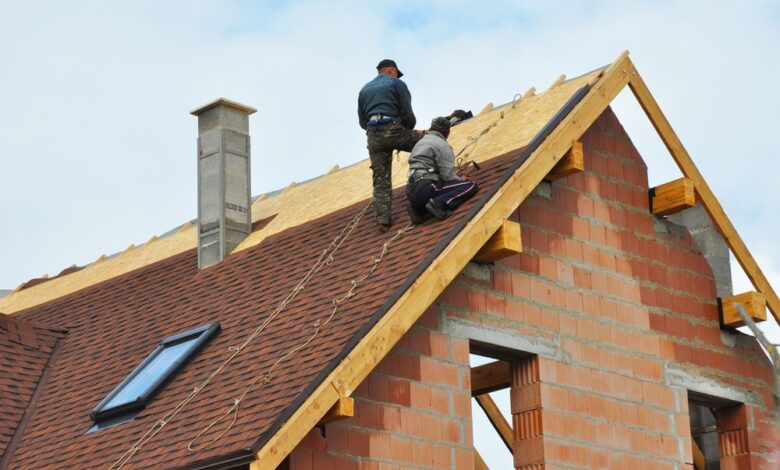What Every First-Time Homeowner Should Know About Roof Installation

Buying your first home is a milestone filled with emotion, paperwork, and Pinterest boards. You imagine the furniture layout, the garden you’ll plant, maybe even the color of the kitchen cabinets. But chances are, there’s one thing you haven’t imagined yet: the roof.
And yet, it’s one of the most vital parts of the house.
Whether you’re moving into a brand-new build or taking on a fixer-upper, understanding how roof installation works—and what it means for your future—can save you money, time, and serious stress. It’s not the most glamorous topic, but it’s one that quietly supports everything else under your new roof.
So, let’s talk about it.
Not All Roofs Are Created Equal
You may have heard terms like “asphalt shingles,” “standing seam metal,” or “composite roofing” thrown around during your purchase process. But these aren’t just buzzwords—they represent real differences in material performance, lifespan, and maintenance needs.
Asphalt shingles are the most common in residential homes because they’re cost-effective and relatively easy to install. However, they typically last 15–30 years. Metal roofs, while more expensive up front, can last 40–70 years and offer high durability.
Other options like clay, slate, or wood shingles provide unique aesthetics and longevity but may not be ideal for all climates or budgets. Knowing what’s on your roof (or what will be) helps set expectations for care and costs in the years ahead.
Understand the Layers
A roof is more than shingles on plywood. A proper roof installation includes multiple layers, each serving a distinct purpose:
- Decking – The base layer, typically plywood or OSB
- Underlayment – A moisture barrier placed over the decking
- Flashing – Metal pieces that protect vulnerable joints and edges
- Ventilation – Systems to prevent heat and moisture buildup
- Shingles or Outer Material – The outermost layer visible from the curb
Skipping or skimping on any of these layers can affect everything from energy efficiency to warranty eligibility. That’s why the quality of installation is just as important as the materials themselves.
Permits and Regulations: What to Ask
In many areas, replacing or installing a new roof requires permits or inspections. As a homeowner, you may not be responsible for pulling the permits directly, but you should ensure whoever does the work is following local regulations.
Ask these questions:
- Is a permit needed for this installation?
- Will inspections be required during or after the job?
- How will you ensure code compliance for this region?
It’s not about being nosy—it’s about protecting your investment and avoiding headaches down the road if you decide to sell or refinance.
Warranties: Read the Fine Print
There are typically two types of warranties involved in roof installation: manufacturer warranties and workmanship warranties.
- Manufacturer warranties cover defects in roofing materials
- Workmanship warranties cover errors made during installation
Some warranties require specific installation methods or certified installers. If these terms aren’t followed, coverage may be voided. Understanding the warranty now helps you make smart decisions if anything goes wrong later.
The Timeline: How Long Should It Take?
A standard roof replacement on a typical single-family home usually takes one to three days, depending on the size of the home and the complexity of the roof design. Weather, crew size, and material type can all affect the schedule.
That said, don’t let speed be the only goal. A quality roofing company will prioritize detail and safety over rushing to finish. Ask for a realistic timeline and how weather delays will be handled. Good communication from the outset sets the tone for a smoother process.
What About Tear-Off vs. Overlay?
If your new home already has a roof but needs updating, your contractor may offer two choices:
- Tear-off – Removing the old roof before installing a new one
- Overlay – Adding new shingles over the existing ones
Tear-offs are more thorough and often preferred, especially if there are signs of water damage or multiple layers. Overlays may save on labor costs but could hide existing problems and add unnecessary weight to the structure.
Make your decision based on the condition of the current roof, long-term goals, and the recommendations of a trustworthy roofing company.
Noise, Debris, and Disruption
Installing a roof is noisy. There’s no getting around that. Expect banging, vibrations, and a good deal of foot traffic around your property. If you work from home, have small children, or pets sensitive to sound, it’s worth planning for those couple of loud days.
Also, be prepared for debris. Professional crews will tarp and clean up, but you’ll want to move outdoor furniture, vehicles, and anything fragile from the perimeter just in case.
Being mentally prepared for this temporary inconvenience helps keep expectations grounded.
Climate Considerations
Where you live matters when it comes to choosing roofing materials and installation techniques. In regions prone to heavy snow, rain, or high humidity, special considerations—such as additional underlayment, ice and water shields, or roof ventilation systems—may be necessary.
For homes in Western North Carolina, for instance, seasonal shifts, strong winds, and moisture exposure are major considerations. A reliable provider like Ridge Runner Roofing is familiar with these regional demands and can guide homeowners toward informed, weather-ready decisions.
Post-Installation Tips
Once your new roof is in place, a little care goes a long way:
- Clean gutters regularly to prevent water backup
- Inspect your roof after major storms
- Trim trees that hang close to or over your roof
- Avoid walking on the roof unless absolutely necessary
Also, keep documentation related to installation, warranty, and inspections in a dedicated home file. These will be invaluable for future resale, insurance claims, or maintenance follow-ups.
The Roof Is the Foundation of Peace of Mind
You may not think about your roof every day—but when it fails, it becomes all you can think about. Starting your homeownership journey with a solid, well-installed roof sets the tone for security, comfort, and long-term savings.
Understanding the basics of roof installation and being proactive about the process means fewer surprises and greater confidence in your home investment.




